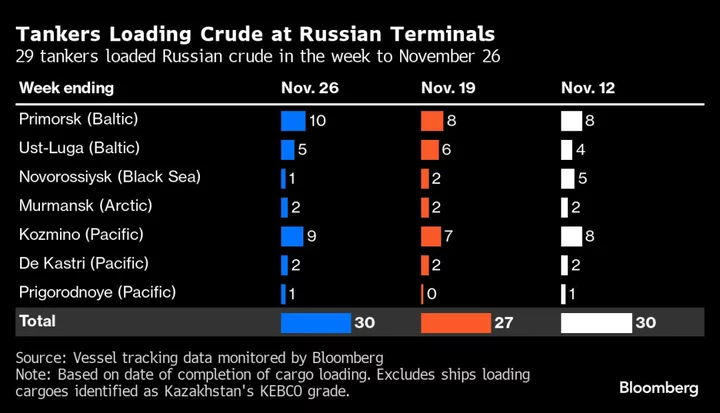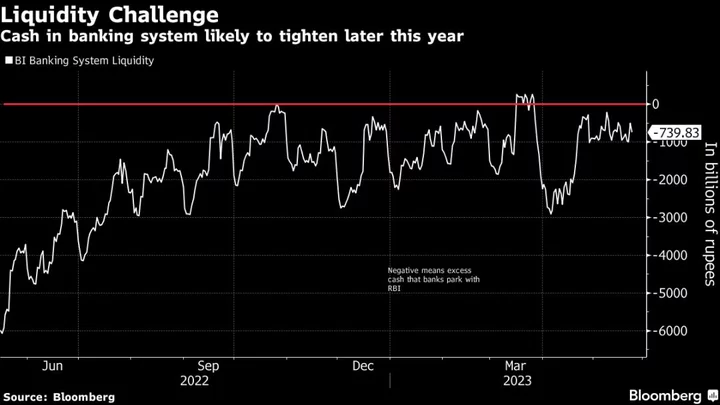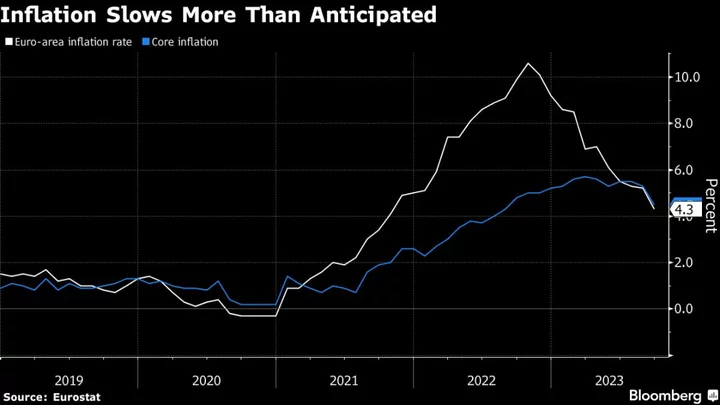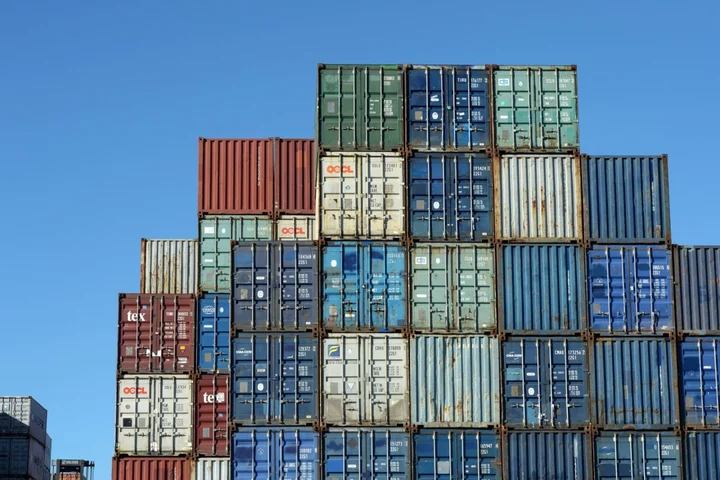Russia’s weekly seaborne crude exports rebounded before a meeting of OPEC+ oil minsters, which has been delayed by disagreements within the group over individual output targets.
About 3.24 million barrels a day of crude was shipped from Russian ports in the week to Nov. 26, tanker-tracking data monitored by Bloomberg show. That was up by 370,000 barrels a day from the revised figure for the period to Nov. 19, even though tanker loading in the Black Sea was disrupted by storms. Four-week average flows slipped.
The OPEC+ group of oil producers, jointly led by Russia and Saudi Arabia, are due to meet virtually on Nov. 30 to set output targets for the first part of next year. The group was forced to postpone its scheduled gathering after some African members objected to lower output targets that were pressed on them back in June. Saudi Arabia is now asking others in the OPEC+ coalition to reduce their oil-output quotas further in a bid to shore up global markets, according to people familiar with the discussions.
Moscow said in early August that it would prolong export restrictions at a reduced rate of 300,000 barrels a day below their May-June average level until the end of the year, a policy confirmed earlier this month. If the burden falls entirely on crude, that would imply seaborne shipments of 3.28 million barrels a day. But Deputy Prime Minister Alexander Novak told Interfax last month that the reduction is spread across both crude and refined products. That complicated assessments of whether Russia was meeting its commitment after the government imposed a temporary fuel export ban in September.
The less volatile four-week average flow fell for a third week, as the last week of October's export surge dropped out of the calculation. Using this measure, shipments dropped to 3.16 million barrels a day, down by about 100,000 barrels a day from the revised figure for the period to Nov. 19. That was the lowest in 12 weeks, but still about 270,000 barrels a day above shipments in the period to Aug. 20, when Moscow’s crude export cuts were at their deepest.
Russia’s oil processing climbed to the highest since mid-August in the week to Nov. 22, as refineries ended seasonal maintenance and the government relaxed fuel-export restrictions.
The Kremlin’s weekly revenues from oil export duties rebounded, recovering most of the previous week’s drop. From January, Russia’s oil producers are set to pay a higher output tax to fund increased downstream subsidies, which were reinstated in October after being halved the previous month. Export duty is set to be abolished at the end of this year as part of Russia’s long-running tax reform plans.Greek oil tanker owners have scaled back how much Russian crude they’re hauling after the US Treasury sent letters to shipping companies for potentially breaching a Group of Seven price cap on Moscow’s oil trades. That may well alarm officials in the Kremlin because the country still needs assistance from foreign vessel operators to get all its barrels to the global market.
Flows by Destination
Russia’s seaborne crude flows in the four weeks to Nov. 26 fell to 3.16 million barrels a day. That was down from a revised 3.26 million barrels a day in the period to Nov. 19. Shipments were about 420,000 barrels a day below the average seen during the surge in volumes between April and June.
All figures exclude cargoes identified as Kazakhstan’s KEBCO grade. Those are shipments made by KazTransoil JSC that transit Russia for export through Novorossiysk and the Baltic port of Ust-Luga and are not subject to European Union sanctions or a price cap.
The Kazakh barrels are blended with crude of Russian origin to create a uniform export grade. Since Russia’s invasion of Ukraine, Kazakhstan has rebranded its cargoes to distinguish them from those shipped by Russian companies.
-
Asia
Observed shipments to Russia’s Asian customers, including those showing no final destination, fell to 2.63 million barrels a day in the four weeks to Nov. 26, down from a revised 2.74 million barrels a day in the period to Nov. 19. That’s well below a peak of about 3.6 million barrels a day seen in May.
About 1.23 million barrels a day of crude was loaded onto tankers heading to China in the four weeks to Nov. 26. China’s seaborne imports are supplemented by about 800,000 barrels a day of crude delivered directly from Russia by pipeline, either directly, or via Kazakhstan.
Flows on ships signaling destinations in India averaged about 870,000 barrels a day in the four weeks to Nov. 26.
Both the Chinese and Indian figures will rise as the discharge ports become clear for vessels that are not currently showing final destinations.
The equivalent of about 485,000 barrels a day was on vessels signaling Port Said or Suez in Egypt, or are expected to be transferred from one ship to another off the South Korean port of Yeosu. Those voyages typically end at ports in India or China and show up in the chart below as “Unknown Asia” until a final destination becomes apparent.
The “Other Unknown” volumes, running at about 26,000 barrels a day in the four weeks to Nov. 26, are those on tankers showing no clear destination. Most of those cargoes originate from Russia’s western ports and go on to transit the Suez Canal, but some could end up in Turkey. Others could be moved from one vessel to another, with most such transfers now taking place in the Mediterranean, off the coast of Greece.
-
Europe and Turkey
Russia’s seaborne crude exports to European countries have collapsed since Moscow’s troops invaded Ukraine in February 2022. A market that consumed about 1.5 million barrels a day of short-haul seaborne crude, coming from export terminals in the Baltic, Black Sea and Arctic has been lost almost completely, to be replaced by long-haul destinations in Asia that are much more costly and time-consuming to serve.
No Russian crude was shipped to northern European countries, or those in the Mediterranean in the four weeks to Nov. 26.
Flows to Bulgaria, now Russia’s only European market for crude, fell to about 83,000 barrels a day in the most recent four-week period.
Exports to Turkey rose to about 420,000 barrels a day in the four weeks to Nov. 26. They remain more than twice as high as they were in July and August.
Vessel-tracking data are cross-checked against port agent reports as well as flows and ship movements reported by other information providers including Kpler and Vortexa Ltd.
Export Revenue
Inflows to the Kremlin's war chest from its crude-export duty rebounded to $81 million in the seven days to Nov. 26, while four-week average income was little changed at $78 million. The weekly income recovered 90% of the loss seen the previous week.
The duty rate for November has been set at $3.57 a barrel, based on an average Urals price of $83.35 during the calculation period between Sept. 15 and Oct. 14. That was about $7.70 a barrel below Brent over the same period. November’s duty rate sets another new high for the year.
The rate for December will be $3.37 a barrel, based on an average Urals price of $79.23 during the calculation period between Oct. 15 and Nov. 14. That was about $9.39 a barrel below Brent over the same period.
Origin-to-Location Flows
The following table shows the number of ships leaving each export terminal.
A total of 30 tankers loaded 22.7 million barrels of Russian crude in the week to Nov. 26, vessel-tracking data and port agent reports show. That’s up by about 2.6 million barrels from the revised figure for the previous week.
There was just one shipment from Novorossiysk, with storms hampering activity at the port for a second week.
Destinations are based on where vessels signal they are heading at the time of writing, and some will almost certainly change as voyages progress. All figures exclude cargoes identified as Kazakhstan’s KEBCO grade.
No cargoes of KEBCO were loaded at Novorossiysk or Ust-Luga during the week.
NOTES
Note: This story forms part of a weekly series tracking shipments of crude from Russian export terminals and the export duty revenues earned from them by the Russian government. Weeks run from Monday to Sunday. The next update will be on Tuesday, Dec. 5.
Note: All figures exclude cargoes owned by Kazakhstan’s KazTransOil JSC, which transit Russia and are shipped from Novorossiysk and Ust-Luga as KEBCO grade crude.
If you are reading this story on the Bloomberg terminal, click here for a link to a PDF file of four-week average flows from Russia to key destinations.
--With assistance from Sherry Su.









